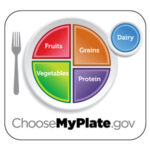Key Facts
- MyPlate outlines 5 important food groups for a well-balanced diet.
- Before you eat, MyPlate can be a reminder of what food groups you should include in your meal.
- You can use MyPlate to help plan meals wherever you eat.

A well-balanced diet includes a variety of foods from different food groups. These food groups are vegetables, fruits, dairy, protein, grains, and fats. MyPlate is a tool that can help you choose healthy varieties of foods from these groups and eat a well-balanced plate at meals.
What is MyPlate?
MyPlate is a tool that was created by the US government to promote a well-balanced eating pattern. MyPlate includes the types of foods you should be eating at most of your meals and encourages a balance of different food groups. By eating foods from a variety of different food groups as outlined by MyPlate, you can be sure you are getting the right amount of energy and nutrients each day for your body’s needs.
Some of the key messages of MyPlate are:
- Make half your plate fruits and vegetables
- Make ¼ of your plate starches and/or grains
- Aim to make at least ½ of your daily grains whole grains
- Make 1/4 of your plate protein
- Ensure a calcium source such as milk or an alternative
- Drink plenty of water throughout the day
What about the foods that are not shown on MyPlate?
MyPlate is a general guideline therefore does not include everything you may eat or drink at meals. For example, water isn’t shown on the plate, even though water is something you should have every day. MyPlate also doesn’t include fats in the image; healthy fats such as olive or canola oil may be used to prepare foods and is also found in foods from other food groups such as in proteins and dairy (fish, nuts, avocados, milk, and cheese). Foods and beverages that we may consider “fun foods” such as desserts, chips, and sodas are also not included in MyPlate. These foods aren’t shown on MyPlate because as part of a healthy, balanced diet, they should not be consumed as often as the other food groups shown.
When can I use MyPlate?
MyPlate can easily be used when sitting down to any meal.
The following are some examples of using MyPlate:
- Breakfast: Egg on a whole wheat English muffin with spinach and tomato, banana strawberry yogurt smoothie
- Lunch: Sandwich with whole grain bread, lean chicken, a slice of cheese, tomato slices, lettuce, and water
- Dinner: ¼ plate of brown rice and beans, ¼ plate of chicken and tomato stew, ½ plate of sautéed spinach and fruit with yogurt
Does my meal need to look like MyPlate every time?
Even though some meals aren’t eaten on a plate or clearly divided into categories, you can still apply the MyPlate principles. For example, a burrito, a slice of pizza, or a bowl of soup may not look like the MyPlate picture; however, the MyPlate concepts will still apply. Think about a slice of pizza – the crust (grains), cheese (protein/dairy), and tomato sauce/topped with vegetables (vegetables)!
Is MyPlate only for eating at home?
The ideas behind MyPlate apply no matter where or what you are eating. At home, MyPlate may be used during family meals, which is a good way to promote healthy habits. For example, planning family meals ahead of time can become easier, since MyPlate shows you how each family member can have a well-balanced meal. Outside of the home, it can be used when ordering from a menu, a buffet line, or at a social event. For example, if you find yourself choosing something with only two food groups such as steak and a bread roll, ask for a side salad or some broccoli.
Where can I find MyPlate?
More information about the MyPlate method can be found here. This website includes educational material and tip sheets for families and people of all ages. Some of the online tools include eating on a budget, MyPlate tip sheets and quizzes, and recipe ideas.
Our health guides are developed through a systematic, rigorous process to ensure accuracy, reliability, and trustworthiness. Written and reviewed by experienced healthcare clinicians from Boston Children's Hospital, a Harvard Medical School teaching hospital and consistently ranked as a top hospital by Newsweek and U.S. News & World Report, these guides combine clinical expertise, specialized knowledge, and evidence-based medicine. We also incorporate research and best practices from authoritative sources such as the CDC, NIH, PubMed, top medical journals, and UpToDate.com. Clinical specialists and subject matter experts review and edit each guide, reinforcing our commitment to high-quality, factual, scientifically accurate health information for young people.
